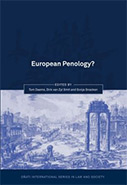European Penology?

Editors: Tom Daems, Dirk van Zyl Smit, and Sonja Snacken
Publisher: Oxford, UK; Portland, OR: Hart Publishing, 2013. 384p.
Reviewer: Russ Immarigeon | March 2014
European criminology has long been of interest. Indeed, the forbearers of a criminal science, including Cesar Beccaria, Cesare Lombroso, Emile Durkheim, Enrico Ferri, Philippe Pinel, Friedrich Engels, Mary Carpenter and many others (Rafter, 2009), were themselves from European countries. Yet, American criminology has tended to relegate these, and more modern practitioners of the discipline, into the historical background of contemporary advances. American criminal justice practitioners and policymakers have also generally avoided consideration of European developments in their day-to-day activities.
However, with the emergence of the European Union, as well as the growth of criminology as an active discipline in various European nations, the subject of a “European penology” or a “European criminology” has come forth as a matter of discussion, if not resolution, within academic circles. And, corrections and criminal justice practitioners have also started to take greater notice of European developments as they work though common concerns regarding matters such as pretrial detention, criminal sentencing, offender programming, victim services, prison overcrowding, and the integration of human rights into daily practice.
“European Penology?” is edited by the three-member team of criminologists Tom Daem and Sonja Snacken, both based in Belgium, and Dirk van Zyl Smit, a South African lawyer currently teaching in England and the United States. The 15 articles that comprise this volume emerged from meetings in 2010 at the Onati International Institute for the Sociology of Law and in 2011 at the Law Institute of Lithuania during the 11th annual meeting of the European Society of Criminology. As a whole, the editors note, these articles serve several purposes, including “a search for a European identity in penal policies and research, a discussion of European institutional developments in penal policies, an overview of comparative research on specific topics in Europe, and a cautious attempt to highlight the differences between European countries.”
The volume itself is divided into three parts: In the first, on “concepts and institutions,” five articles describe different European definitions of penology, the importance of the Council of Europe and the European Union in determining the region’s penological work, the influence of European self-identity in approaching penology, and the nature of sanctions across Europe. In the second, another five articles address “cross-cutting issues,” such as immigration, European values, youth justice, community sanctions, remand or pretrial detention, and prison privatization. In the third, a final five articles on “nationally-directed perspectives” concerning prosecutorial independence in Italy, the oversimplification of sentencing reforms in Belgium, the non-public nature of criminal records in Spain, changing penal practices in Poland and other eastern European countries, and a refreshed period of reduced emphasis on imprisonment in The Netherlands.
In addition to the editors’ introductory and other writings in European “Penology?”, the authors of these articles in this volume include a cast of well-known contributors, including U.K. criminologists Ian Loader, Richard Sparks, Fergus McNeill, and Alison Liebling; Dutch criminologist René van Swaaningen; Brussels-based penologist Kristel Beyens; German criminologists Frieder Dunkel and Christina Morgenstern; Italian criminologists Dario Malossi and David Nelken; and eastern European jurists Krzysztof Krajewski and Roland Miklau.
The question mark at the tail of the term “European penology” is well-placed, for from the first pages of this volume it is clear that disunion is more typical than union in the European matters at the center of this volume. Definitional differences abound, national differences are many, and even within nations there are countervailing forces. I claim no dimension of national pride when I suggest that this sounds very American, where consensus on criminal justice means different things at different times in different places. More than anything, this volume is a work of comparative criminology, and as such it is best gleaned for its contributions to an understanding of different possibilities in policy and practice. What various nations do, beyond well-considered recommendations, with the abundance of knowledge contained in this volume is more of a mystery than even these insightful authors and editors can resolve.
In the opening chapter, building on an earlier effort (van Zyl Smit and Snacken, 2009), Dirk van Zyl Smit and Sonja Snacken quickly encounter a definitional diffusion that results in perspectives that are freewheelingly narrow or broad. Penology, which certainly includes both the administration and study of prisons, may well be less monitored than the institutions under review. Van Zyl Smit and Snacken favor a “critical penology,” which is not entirely European, or clearly defined, but it also has its European markers, including an important social as well as legal emphasis on human rights.
As various authors in this volume note, the organizational structures of the European Union and the Council of Europe have had great influence, at least in terms of placing “rules and standards” at the forefront of penal observers, whether from academic , governmental, or private sector quarters. Yet differences, and some significant uncertainties, persist.
Concerning Poland, for example, Krzysztof Krajewski sketches differences between “old” (western) and “new” (central and eastern) Europe. Even intensive implementation of the aforementioned “rules and standards” has not ironed out many of these differences, which resist such efforts at penal reform. Krajewski concludes, “communist penal practices created a specific ‘culture of control’ that seems to have survived well beyond the communist system and still makes a crucial contribution to current crime control policies. These practices may be influenced and reinforced by many other factors. But the main reason for punitive crime control policies in Poland and other countries of Central and eastern Europe seems to be continuation of the old-style punitiveness inherited from the communist past, and not a ‘new punitiveness’ that is an expression of a postmodern penality.”
In his closing chapter, “Reversing the Punitive Turn: The Case of the Netherlands,” René van Swaaningen similarly raises his hands in frustration. As is well-known, the Netherlands’ once low imprisonment rate soared over the course of two decades, only to start declining to previous levels, contrary to either expectations or explanations. Still, in reporting “some useful factors that determine both punitive turns and penal reductionism,” he hopes “to avoid the grim pessimism that characterizes most of the literature on punitiveness.”
“European Penology?” thus starts with a grand agenda and ends with some encouragement. If nothing else, it sets the stage for further, and deeper, investigations not so much into what to label what is occurring in regional and national locations, but rather into what is actually happening in these settings, namely, individual and organization actions, legal and social reforms, social and economic conditions, and day-to-day activities in penal environments.
References:
Rafter, Nicole, ed. (2009). The origins of criminology: A reader. New York: Routledge.
van Zyl Smit, Dirk and Snacken, Sonja (2009). Principles of European prison law and policy: Penology and human rights. New York: Oxford University Press.
Russ Immarigeon, local “town and village” court justice, upstate New York


